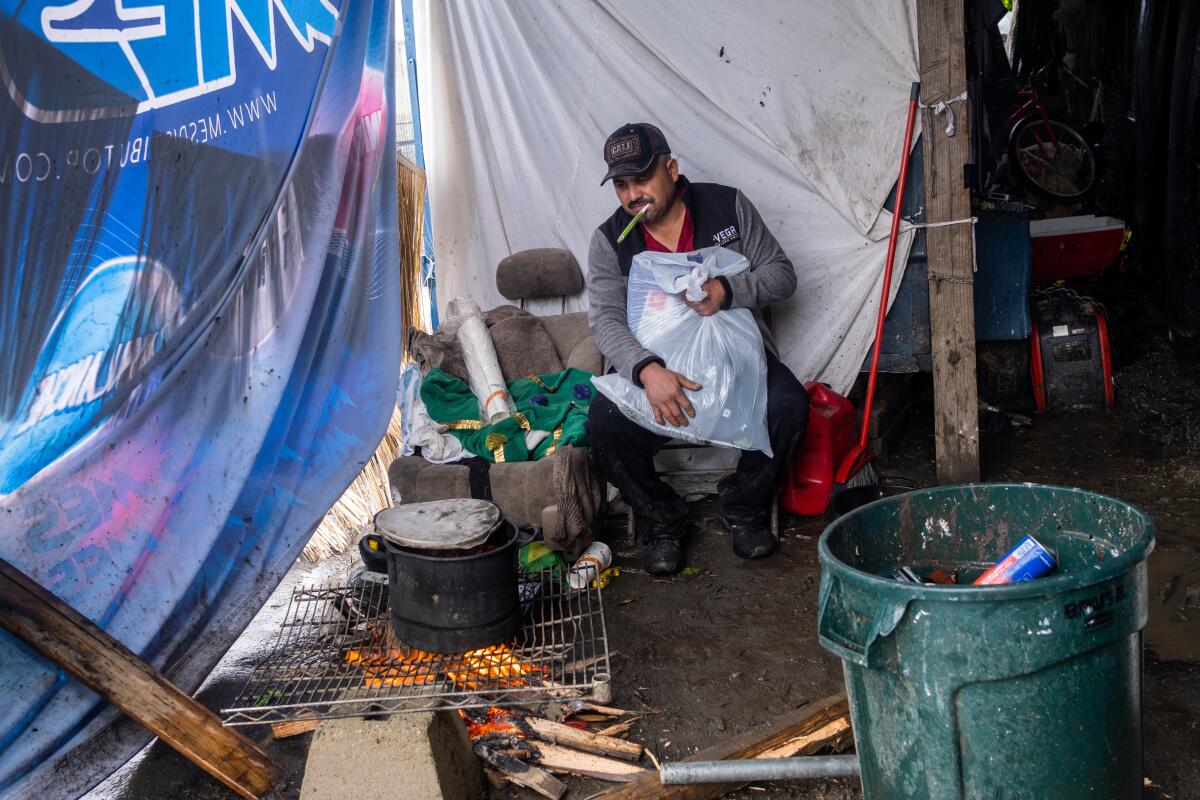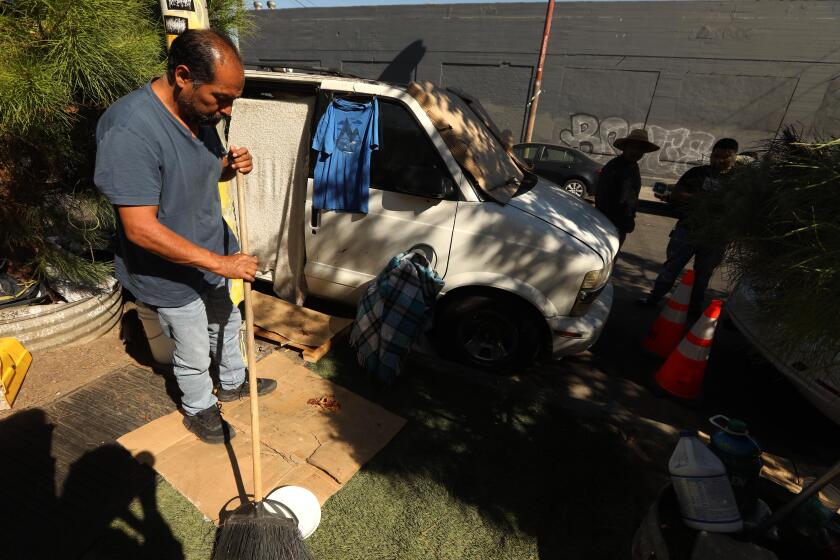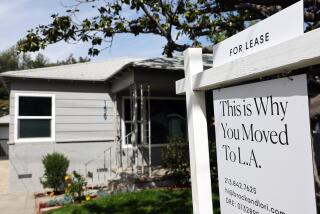Monthly payments of $1,000 could get thousands of homeless people off the streets, researchers say

A monthly payment of $750 to $1,000 would allow thousands of the city’s homeless people to find informal housing, living in boarding homes, in shared apartments and with family and friends, according to a policy brief by four prominent Los Angeles academics.
Citing positive preliminary results of pilot studies in several cities, including Los Angeles, they argue the income could provide access to housing for a portion of the population who became homeless primarily as the result of an economic setback. This could ultimately save millions of dollars in public services, they argued, and leave the overstretched and far more expensive subsidized and service-enriched housing for those who have more complicated social needs.
“If the idea is to reduce the number of people on the street, definitely the fastest way to do that is money and not this incredibly complex system that we have built up primarily to help people with serious disabilities,” said lead author Gary Blasi, a professor emeritus in the UCLA School of Law.
The paper offers no prescriptions for how the payments should be funded or who should receive the money. Instead, the authors, coming from four separate disciplines, contrast the simplicity and documented effectiveness of basic income with the high cost and inadequate results of programs to provide standard housing for every homeless person.
“The truth is, we cannot afford not to do better than the current system, which spends a huge amount of money to house a small fraction of those in need,” they wrote.
That system, relying on housing navigators to “seek very scarce subsidized housing subject to strict criteria” is a “lengthy and expensive process” leaving thousands of rental subsidy vouchers unused and thousands of people unable to find housing.
Homelessness among Latinos has shot up in Los Angeles County while other demographic groups have seen a decline over the last two years.
“Providing interim housing during this process can be very costly, as is adding to the supply of housing,” they wrote.
Meanwhile, a source of readily available affordable housing goes untapped.
“Informal housing, once a subject of study only in developing countries, means housing that does not conform to the standards of the formal housing market,” they wrote. “It includes shared housing arrangements, housing that does not meet all code requirements, rooms rented in single-family homes.”
“There’s a vast informal rental market going on already all across California,” co-author Sam Tsemberis, a clinical community psychologist with the UCLA Department of Psychiatry, said in an interview. “People are renting out single-family homes. They have two or three beds in each of the bedrooms and are charging $400, $500 a month for people to sleep.”
Tsemberis is the founder of Pathways to Housing, a New York program that pioneered the Housing First approach now adopted across the nation as a model for housing chronically homeless people with compounding issues of mental illness and substance abuse.
Basic aid is not a substitute for housing first, Tsemberis said.
“This is for the group that has more resources internally, a work history, isn’t struggling mightily with mental illness or addiction,” he said.
Pointing to research by the Benioff Homeless and Housing Initiative at UC San Francisco, the authors suggest that more than half of people living on the streets fall into that category.
The study found that fewer than a third of a large sample of unhoused people in California had been tenants in “ordinary” housing before becoming homeless. “Most were last housed in a unit rented by someone else — i.e., the informal housing market. If they were required to pay rent, their median monthly rent was $450.19,” they wrote.
The authors cited a 2022 survey by Urban Institute of guaranteed income programs in Austin, Chicago and Arlington County, Virginia, that found cash subsidies provided more flexible housing support at lower cost, allowed recipients more dignity, avoided voucher discrimination by landlords and served people who were ineligible for government subsidies.
While those programs, and similar ones currently under way in Los Angeles County, are for a general population, a preliminary study by one of the authors has found that homeless people also benefit.
Ben Henwood, director of the Center for Homelessness, Housing and Health Equity Research at the USC Suzanne Dworak-Peck School of Social Work, designed a controlled study of a cash stipend pilot mounted by the San Francisco-based nonprofit Miracle Messages.
Early results were so promising that Henwood released a preliminary six-month analysis breaking down recipients’ spending as 36.6% food, 19.5% housing, 12.7% transportation, 11.5% clothing and 6.2% healthcare, leaving only 13.6% uncategorized.
“The idea that to give poor people money is controversial is just strange to me,” Henwood said. “Of course that will help.”
Blasi, a lawyer who has for decades engaged in litigation involving housing, welfare, homelessness, and redevelopment and started the Legal Aid Foundation of Los Angeles’ Eviction Defense Center in 1983, said Henwood’s study inspired the idea for the brief.
Along with Henwood and Tsemberis, Blasi brought in Dan Flaming, president of the Economic Roundtable.
Flaming has led research that documented the high cost of public services for chronically homeless people. He recently conducted a study that used predictive tools to identify individuals likely to be persistently homeless and provided them housing, mental health therapy and apprenticeship training for union jobs.
At its conclusion, twice as many participants were housed and 40% more were employed than at its inception.
“The larger perspective is that homelessness is a result of economic inequality and income at least as much as it is a lack of affordable housing,” Flaming said. “I don’t see a way that we can house our way out of homelessness. This is another tool, the tool providing people a basic income, that we need to be making a better use of.”
While not proposing a specific administrative plan, the authors point to a potential mechanism for implementing basic income: raising General Relief, the county program mandated to provide minimal assistance to people who are “destitute, unemployed and ineligible for any other form of assistance.”
“Liberal L.A. County hasn’t raised the GR grant in 40 years,” Blasi said.
Since the 1970s the rate has been $221 per month. If it had risen with inflation, it would be $1,008.
“Unsurprisingly, the County’s Department of Public Social Services reports that about 75% of the more than 100,000 General Relief recipients are homeless and have no stable address.” they wrote.
The paper anticipates, and counters, the potential objection that their plan would push people into substandard housing.
“There is no reason to think that housing will be worse than the last stable housing they had before becoming homeless,” it said.
“I don’t have any illusions that people are going to be living in places that middle-class people would find acceptable,” Blasi said.
Informal housing is no substitute for the thousands of units of supportive housing that are needed.
But “somewhere around half of the people on the street and in those encampments don’t need supportive housing,” he said. “They don’t. And they don’t qualify for it and they’re not getting into it,” Blasi said.
“We’re sort of communicating if you can just hang on for four years on the street, you’ll be troubled enough that you will rise to the top of our list. That’s just crazy.”
More to Read
Sign up for Essential California
The most important California stories and recommendations in your inbox every morning.
You may occasionally receive promotional content from the Los Angeles Times.












